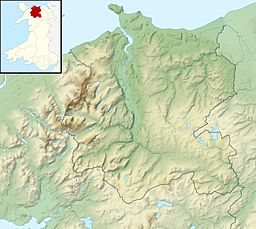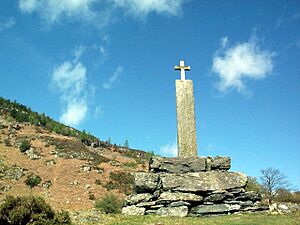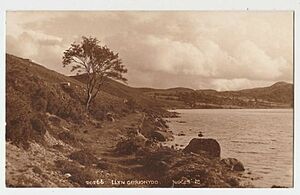Llyn Geirionydd facts for kids
Quick facts for kids Llyn Geirionydd |
|
|---|---|
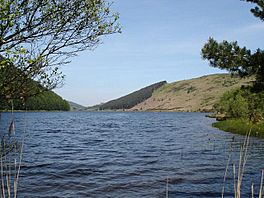 |
|
| Location | Snowdonia, North Wales |
| Coordinates | 53°7′53″N 3°50′57″W / 53.13139°N 3.84917°W |
| Type | natural |
| Primary outflows | Afon Geirionydd |
| Basin countries | United Kingdom |
| Surface area | 45 acres (18 ha) |
| Max. depth | 50 ft (15 m) |
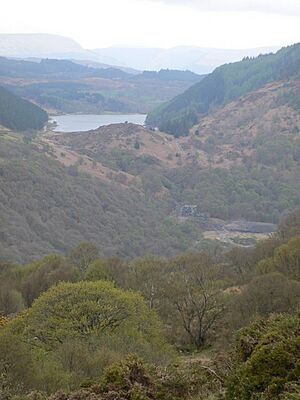
Llyn Geirionydd is a beautiful lake found in a valley in North Wales. It sits where the northern part of the Gwydir Forest meets the lower slopes of the Carneddau mountains. The lake is nearly a mile long and covers about 45 acres. It is never deeper than around 50 feet.
You can reach the lake by car from Trefriw or Llanrwst in the Conwy valley. The road passes through the small village of Llanrhychwyn. You can also get there from a road that goes through the Gwydir Forest. Getting to the lake isn't super easy, but it's the only lake in Snowdonia where you can use power boats and go water skiing! Many visitors also walk to the lake from Trefriw village. It's part of the Trefriw Trail walking routes. You can also walk from the nearby Llyn Crafnant, which runs next to it, about a mile away. The two lakes are separated by Mynydd Deulyn, which means "mountain of the two lakes."
Template:TOC limit=3
Contents
Visiting Llyn Geirionydd
The lake has a car park with toilets, and it's a very popular spot in the summer. This car park was once a place where waste from the Pandora mine was dumped. Planting conifer trees in the area has helped to hide the effects of past mining. There are very few, if any, fish in the lake. It's thought that this is because of pollution from the nearby metal mines.
The River Geirionydd
The Afon Geirionydd flows out of Llyn Geirionydd. It goes down a steep canyon called Geirionydd Gorge, which is popular for gorge walking. At the bottom of this gorge are the remains of the Klondyke mill. This mill used water from the river to power its machinery.
Klondyke Mill and Tramway
The Klondyke mill processed its own metals. It also received lead and zinc ore from the Pandora mine. A tramway, which is like a small railway, carried the ore from the mine. Part of this tramway ran along the route of what is now the lakeside road. You can still see where it ran between the road and the lake on the northern side, where the road goes uphill a bit. This tramway continued to a spot above Klondyke mill. From there, wagons entered the mine using an aerial ropeway, like a cable car system. This last part of the tramway is a public path that goes above the valley and eventually reaches Trefriw. Below Klondyke Mill, Afon Geirionydd joins Afon Crafnant. Afon Crafnant flows out of the neighboring Llyn Crafnant and eventually joins the River Conwy.
Roman Road Connection
The road that exists today follows what some people believe was part of Sarn Helen. This was a Roman road that went south from the fort at Canovium (which is now Caerhun, between Trefriw and Conwy). It continued to the fort at Tomen y Mur (near Trawsfynydd) and even further, eventually reaching Moridunum (Carmarthen).
Nearby Llanrhychwyn
The closest village to Llyn Geirionydd is the small hamlet of Llanrhychwyn. This village has connections to Llywelyn Fawr, a famous Welsh prince. Llywelyn had a hunting lodge in Trefriw, but he used Llanrhychwyn church. Many people consider this church to be the oldest church in Wales.
Literary Connections
Llyn Geirionydd has inspired many writers and poets:
- Ieuan Glan Geirionydd (1795–1855) was born near the banks of Afon Geirionydd. He was well-known for his poetry and hymns.
- Taliesin (around 534–599) was a Welsh bard, or poet, from the 6th century. He is one of the earliest Welsh poets whose work still exists today. He lived near Llyn Geirionydd, and many believe he is buried there. The Red Book of Hergest contains a line that says, "I being Taliesin, from the borders of the lake of Geirionnydd." Some sources claim he was born in this area, but it's more likely he was born in Powys.
- John Roberts (1828–1904) was from nearby Trefriw. He was a printer and bookseller. In Eisteddfodau (Welsh festivals of literature, music, and performance), he used the bardic name Gwilym Cowlyd. He felt that the main Eisteddfodau were becoming too "English." So, in 1865, he started his own festival to compete with the big National Eisteddfod. He called it Arwest Glan Geirionydd, which means ‘Music Festival on the Banks of the River Geirionydd’. The meeting point was Bryn y Caniadau, or "hill of verse." The Taliesin Memorial by Llyn Geirionydd remembers these festivals, even though the memorial isn't exactly on Bryn y Caniadau itself.
- David Francis (1865–1929) became famous as “The Blind Harpist of Meirion” at these alternative Eisteddfodau.


